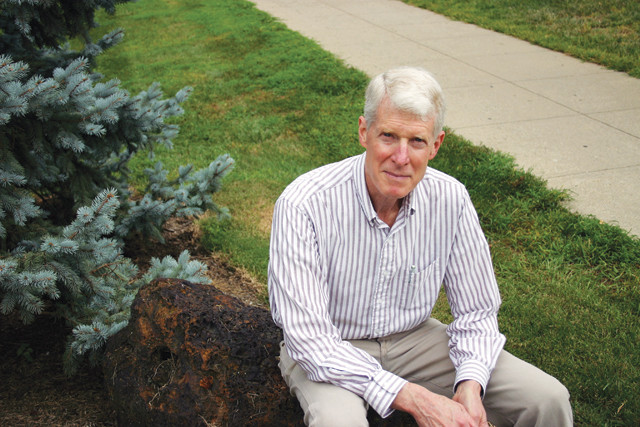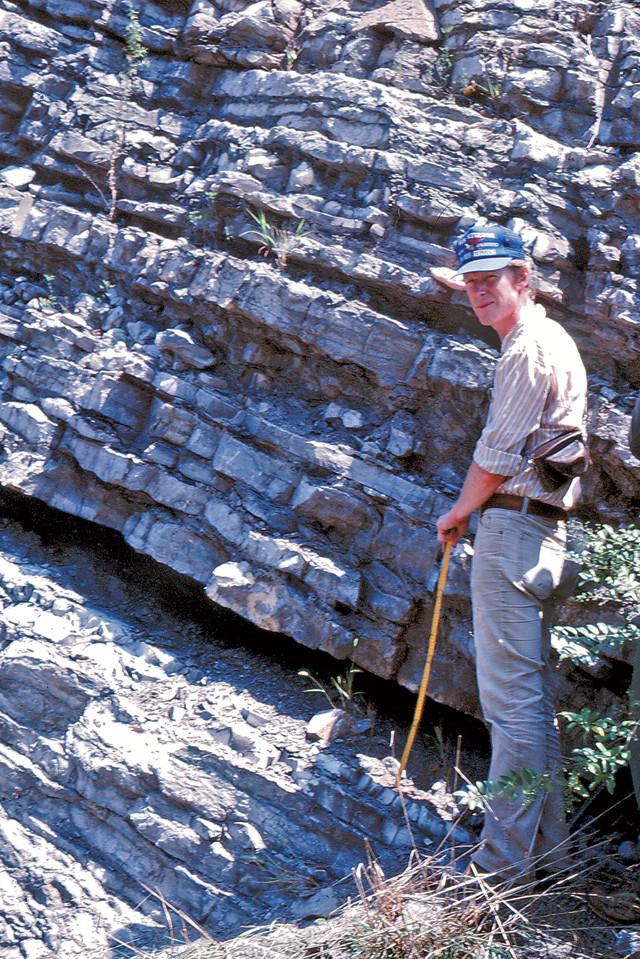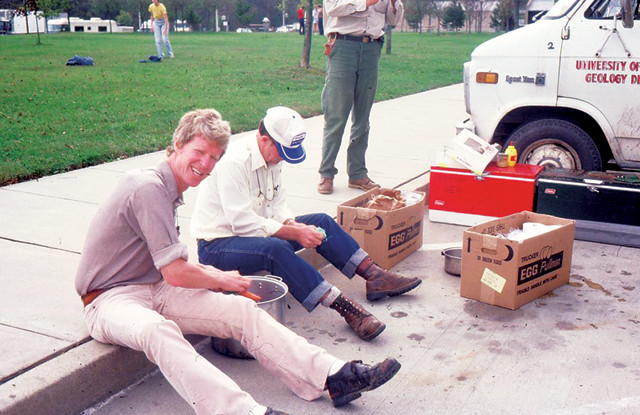
by Sarah Derouin Friday, December 21, 2018

Clay mineralogist Warren Huff taught at the University of Cincinnati (UC) for 55 years. He is still active as a professor emeritus and is a great supporter of bringing UC alumni together, especially at Geological Society of America annual meetings. Credit: courtesy of Warren Huff.
Two distinct images come to mind when I think of Warren Huff, my former doctoral adviser: one in which he is enthusiastically teaching and mentoring students both in and out of the classroom, and one in which he is sitting around a fire, playing guitar and leading a group of geologists in science-themed sing-alongs. Both images encapsulate the kind of person he is: a leading scholar in the field of clay mineralogy who lives life with gusto.
Huff grew up in Michigan, on his family’s farm, which featured cattle, a Victory Garden (it was during World War II) and chickens that provided the neighbors with eggs. Huff and his brothers spent summers wrangling cattle: “We rode horses and wore hats, chaps, cowboy boots and everything,’ he says. Huff’s father was hoping one of his three boys would want to take over the farm, and Huff planned on returning home after graduating from Harvard. But a freshman geology class changed everything. “I remember the expression on my father’s face when I said I really wanted to major in geology,” Huff says.
He went on to graduate school at the University of Cincinnati (UC), where he completed his master’s project and jumped straight into doctoral studies focused on clay mineralogy. After his defense, he was getting ready to go to Houston to interview with oil companies when the head of the department caught him in the hall one day and asked if he’d like to join the department as a faculty member. Huff met with the dean who asked him if he was married. After responding that he wasn’t, the dean said, ‘Well, you won’t need a very big salary then,’ and made Huff an offer. He accepted, and ultimately spent his entire career at the school. Last year, after 55 years, he retired from UC as professor emeritus.
I sat down with Huff to talk about his decades of research, his passion for using technology in teaching, and the approach to work-life balance that served him well throughout his career.
SD: How did you become interested in clay mineralogy — did you take a class about it?
WH: No, there were no classes in clay mineralogy. I had gone on a lot of field trips around the Cincinnati area, and I was becoming more familiar with the regional geology. When I was in graduate school, the department hired a faculty member named Frank Koucky; Frank was a mineralogist and a specialist in X-ray diffraction. With Frank’s help and the department’s funding, we bought our first X-ray refractometer. It was installed in the basement and I was fascinated with what it could do.
For example, I thought: How do we study the minerals in shale? Frank was aware that there was a whole field of study of about clay, but he didn’t know much about it. But he’d graduated from the University of Illinois and there was a fellow at Illinois named Ralph Grim who had written the iconic textbook on clay mineralogy. Frank took me over to Champagne and I met with Ralph Grim and had a lovely chat one afternoon. He encouraged me to do some reading, told me about this book, and told me about some of the literature in the field.

Huff has collaborated with scientists all over the world to uncover details about past volcanic eruptions using clay minerology. Credit: Dennis Kolata, Illinois State Geological Survey.
SD: What is clay mineralogy and why is studying it useful?
WH: Well, you have to think about how clay is formed in the first place. Physical and chemical weathering processes break down surface rocks, and clay is a byproduct. The nature of that clay will depend on the intensity of the weathering, the duration of the weathering, and of course, what the parent material is. So, clay minerals developed from granite over a long period of time might be different from what would develop on, say, metamorphic rocks that weathered only for a short period of time. The nature of clay minerals changes over time, and they change as a function of burial as well. Clay in soil might have certain mineral characteristics, but if that soil becomes buried or overlain by some other material, compaction and pressure over time will change the nature of the clay minerals. This is one of the big topics of study: Could you look at clay and, for example, tell something about what its thermal history has been?
Clay is used a lot in industries and manufacturing processes as well. People in the ceramics industry, for example, like kaolinite. Kaolinite is the primary ceramic clay, and they search very hard for areas where rocks have a lot of feldspar in them and have been deeply weathered but not buried. If you go to Georgia today, they have some of the largest kaolin companies in the world because the southern part of the Appalachians has a lot of weathered rock that has not been deeply buried.
SD: Much of your work has focused on potassium bentonites, also called K-bentonites. Can you explain what those are?
WH: I started studying bentonite layers in Ordovician rocks in Kentucky, and what I discovered was that they … were what we now refer to as mixed-layer clays. In other words, they are a mixture of layers of smectite [an expandable clay] and illite [a nonexpandable clay]. This was a real puzzle at first. I wasn’t the first person to start working on this — there were several other clay mineralogists in the field who had recognized this characteristic. The conversion of smectite to illite involves the addition of potassium, which prevents the clay layers from swelling, so we call them potassium- or K-bentonites.
Studies have shown that the degree of potassium interaction increases with greater depth of burial and higher temperatures. So you can look at the ratio of expandable to nonexpandable layers and get some idea of the temperature to which this particular layer has been subjected.
The thing that turned out to be very interesting was that these K-bentonites are all over the world, and it seemed like somebody needed to go and study them because there wasn’t a global pattern. I started publishing a lot on this, and that got other people interested as well. We’re using them not only to look at the ratio of illite to smectite. It also turned out that if you trace a particularly widespread bentonite bed, it can act as a good time line for stratigraphic correlation.

Huff scrubs carrots while on a UC geology field trip. Credit: courtesy of Warren Huff.
SD: Is clay mineralogy an interdisciplinary field?
WH: It’s very interdisciplinary. It’s more than just geology; it also applies to engineering, and it applies to agriculture. Then the whole field of nanoparticle science has emerged in recent years. At our annual meetings of the Clay Minerals Society, it’s not unusual now to have chemists or physicists presenting because they’re dealing with small particles, and those fields don’t have societies that specialize in small particles — but the Clay Mineral Society does.
SD: You were one of the first professors to offer online classes at UC. How did that get started?
WH: It started, not because I thought there was a need for it, but because I was interested in the technology — it was totally technology driven. I was at a conference and saw a short video of a lecture that somebody had produced using software you could put on your computer to capture a video and audio lecture. I thought I could do that with my lectures and just post them for students. So I started doing this just as an experiment, and I’ve continued it since.
The challenge for the instructor is that online classes take time. My wife asks me: “Why on a Sunday morning are you sitting here at the computer?” It’s because people are asking questions about the homework assignments and this is the time when they can work. A lot of UC students work part time or full time. There are lots of reasons why physically coming to campus is a challenge. I think [online class offerings] are going to increase as we go forward.
Classically, the definition of a course is you have a talking head up in front of the room and people sitting there listening and taking notes, but technology is transforming how people learn. There are a lot of strategies that are being developed for online learning, so it’s an interesting and rapidly developing field.
SD: Is it true you once told another professor that once they had tenure, they needed to get a hobby?
WH: Yes, that’s true. You need to have things that fill your life because your life isn’t just your academic pursuits — you need to have your personal life too. One of the hobbies that I have is baking bread. I like to make no-knead bread. You put all the ingredients together and let it sit overnight and it sort of inflates into big bubbly ball of stuff. Then you plop it in a Dutch Oven, hike the temperature up to 500 degrees Fahrenheit for half an hour, and it just expands and makes beautiful, beautiful bread.
Another hobby I have is playing music: fiddle and guitar. Usually, every night after dinner I try to play fiddle for an hour or so. On weekends, I usually get together and jam with people and play music. I’m not a really good fiddle player, but it’s so much fun.
© 2008-2021. All rights reserved. Any copying, redistribution or retransmission of any of the contents of this service without the expressed written permission of the American Geosciences Institute is expressly prohibited. Click here for all copyright requests.